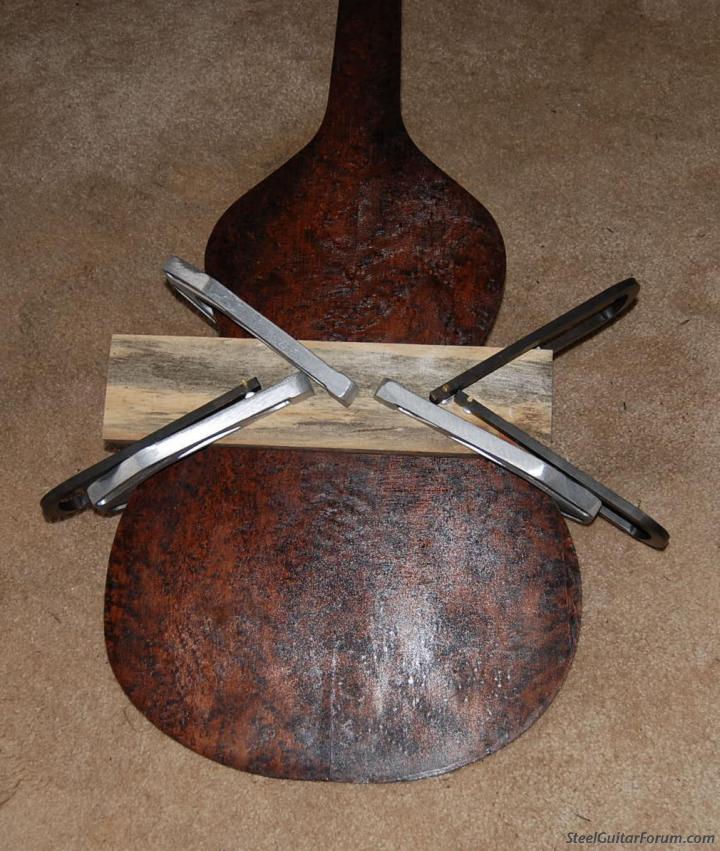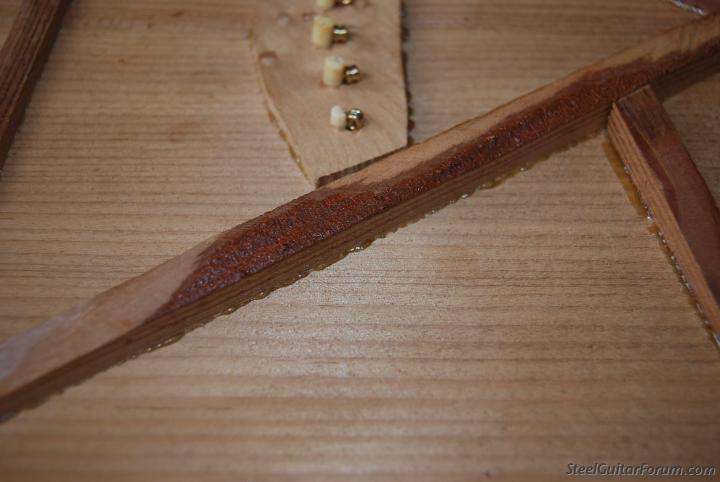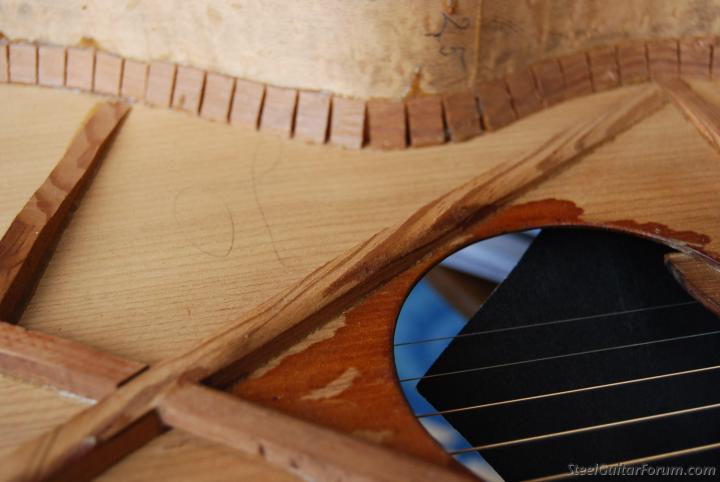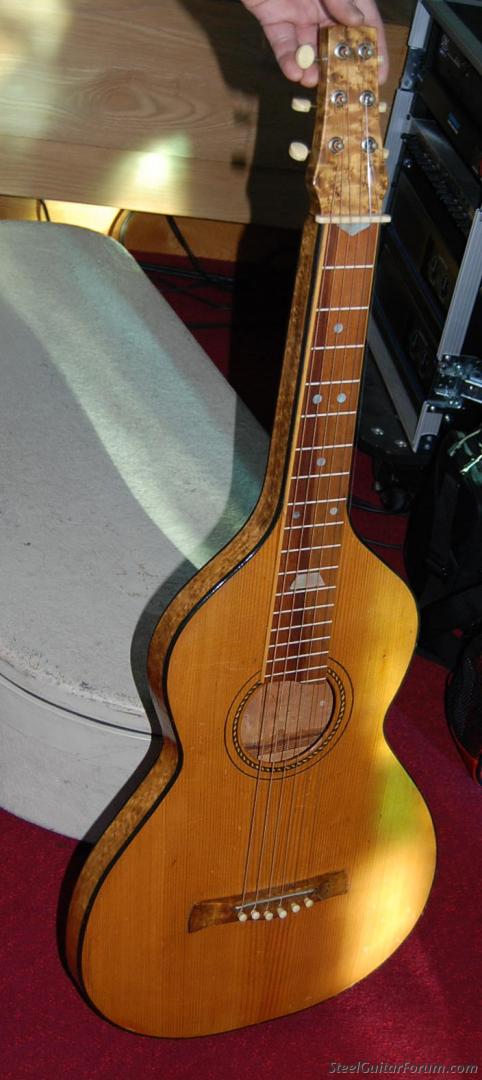| Author |
Topic: Dating Weissenborn's |
Christopher Wray
From:
California, USA
|
 Posted 8 May 2011 11:53 am
Posted 8 May 2011 11:53 am |
|
Hello Gents,
I've been looking all over the internet for information on how to date Weissenborn's, specifically Style 1's and I'm not finding anything helpful. I've found a few sources that say you can date them by bridge variances, tuners, etc. but there aren't any specifics. I'm sure there are a few walking encyclopedia's on the subject in the forum. Any help would be much appreciated.
Also... Are the Weissenborn's with the picture inside them older or newer? Are the older one's more desirable? I've noticed that the few I've seen with the picture label also have the thinner more "bat wing" looking bridge. I'm interested to know around what year that would have been made.
Thanks!! |
|
|
 |
Jim Sallis
From:
Arizona, USA
|
 Posted 8 May 2011 8:06 pm
Posted 8 May 2011 8:06 pm |
|
| This book will answer your questions: Chris J. Knutsen: From Harp Guitars to the the New Hawaiian Family, by George T. Noe & Daniel L. Most. A treasury of information, with a wonderful chapter on Weissenborns containing discussions of styles and eras and offering excellent photos of many guitars. |
|
|
 |
Ben Elder
From:
La Crescenta, California, USA
|
 Posted 8 May 2011 9:15 pm Immodest to say
Posted 8 May 2011 9:15 pm Immodest to say |
|
...but I am the walking encyclopedia on Weissenborns. I spent a lot of the 90s in the catacombs of the LA County Hall of Records and Downtown library...mostly because I had found that no one else ever had done any substantive research on Weissenborn. Fortunately I worked nearby.
(I have 8, 9, 10 file boxes full of papers, photos and what-not and a deep-bodied case of writer's block vis-a-vis putting together a book. Contrary to what a leading expert once opined--that Weissenborns might amount to a footnote to a chapter about Dobros, Nationals and resonators--I'm overwhelmed by the subject of Weissenborns alone.)
I refer you to my article in ACOUSTIC GUITAR Magazine (#37, Jan. 96, reproduced promiscuously by GoldTone on their website.)
Only two niggling corrections to make to that in the interim: Style 2's black binding is phenolic, not celluloid and teardrops were not really a reaction to the Depression. They apparently were being made even before the Depression had a chance to take hold and spread.
Sadly, there are virtually no serial numbers (the four or five known are probably post-factory) and the only key to knowledge is the mind-numbing matrix of features, measurements and the familiarity with those to fit a particular instrument on the timeline. And here's a tip from someone who's been obsessing over all this for a generation: even if you can tell relatively where a Weissenborn fits on the hollowneck continuum, nailing down a date means adding "circa" in front of the year. I've only seen one instrument with original receipt. (An early Kona with 1923 written on the payment ticket book.) A moving company map of Los Angeles serendipitously tells me the year an early Weissenborn was probably made. (I'm sparing you those particular details for now.)
There were early labels ca. 1914-17 (no photo/type only and maybe no Hawaiian guitars this early) maybe simultaneous with unmarked instruments which gave way to labels which gave way to the stamp (by about 1924) at which point he probably hadn't yet hit his stride as far as output. (His stride would be hobbled by National about four years hence.)
Unless you have a high-precision carbon-dating app on your iPhone, there's no magic bullet.
As to what's best, your ears are the final judge. I say this, he says that and there's not really a Loar F-5- or '59 LP Sunburst-like consensus that I've seen. (Just by way of example, my personal favorite was restored after being submerged and later spray-painted.) Any Weissenborn you find that means not having to settle for a Hilo or modern pale imitation* should be weightily considered without fretting over small, two-piece or large bridgeplates and such.)
*--There are modern vivid imitations, also worth considering.
If there are any historical forensic accountants out there, I'd love a word with you.
_________________
"Gopher, Everett?"
Last edited by Ben Elder on 26 Jun 2018 3:16 pm; edited 1 time in total |
|
|
 |
Rob Anderlik
From:
Chicago, IL
|
 Posted 9 May 2011 4:04 am
Posted 9 May 2011 4:04 am |
|
| The article Ben refers to from Acoustic Guitar is a must for anyone interested in Weissenborns! |
|
|
 |
Brad Bechtel
From:
San Francisco, CA
|
|
|
 |
Christopher Wray
From:
California, USA
|
 Posted 9 May 2011 9:57 am
Posted 9 May 2011 9:57 am |
|
| Thanks for the info guys!! Ben, which one's seem to be more desirable/valuable? The earlier or later ones? Also, do only the earliest Weissenborn's have the picture label? What should one look for when thinking about buying an original? Bill Asher gave me some good tips like always checking the braces. I just wondered if there was anything else I should be looking for or staying away from. |
|
|
 |
George Noe
From:
Washington, USA
|
 Posted 10 May 2011 7:20 pm Dating Weissenborns
Posted 10 May 2011 7:20 pm Dating Weissenborns |
|
Actually, there is a way to date Weissenborns. Beginning 1914, HW built guitars using his stock of violin wood, namely birds-eye maple and spruce, with Douglas fir braces. The first of these had green dressmakers' seam tape for a backstrip, then maple was used for the backstrip. Violin varnish was used on these early guitars, which have mostly Style 2 appointments with some Style 4s thrown in, although styles weren't solidified until 1923. The picture labels came along about the time of the Panama Pacific International Exhibit in late 1915 and were used until 1923. The guitars of the 1915-1922 period are also generally Style 2 configuration, koa with spruce tops and then all koa. A handful of solid-neck Weissenborns with Style 3 and 4 appointments were built in the 1916-1922 time frame, with only 6 known to exist. It gets easier when the factory opened in 1923 because HW used a burned-in stamp that progressively became worn, as observed by the brand itself on the backstrip. Henry Stadlmaier was sole east coast distributor 1923-1927, and his brand is burned in to many instruments of this period. Tonk Brothers of Chicago took over national distribution in 1928. The bridge from 1923 to 1927 was 6-1/4 inches point to point, and then shortened to 5-1/2 inches in 1928 as the top was beefed up to increase volume. Bridge pin arrangement went from a V to a shallow arc in 1926. Shellac was used 1915 to 1927, and then nitocellulose lacquer was used thereafter. The teardrop-shaped guitars were manufactured at least as early as 1929 as dated by the patent pending Waverly tuners on mine. I show photos of several Weissenborns in my book along with spotting features to date them.
George T. Noe |
|
|
 |
Tony Francis
From:
Aotearoa / New Zealand
|
 Posted 11 May 2011 11:47 pm
Posted 11 May 2011 11:47 pm |
|
| Quote: |
| ...but I am the walking encyclopedia on Weissenborns. |
And modest too!
All kidding aside, we are all looking forward to your book Ben, whenever you get around to it!
| Quote: |
that Weissenborns might amount to a footnote to a chapter |
I am not sure if this is directed at George's book or not but either way I have a few thoughts.
The Most/Noe book mentioned as above by Jim is the essential book for anyone interested in Weissenborn and related instruments. Although Weissenborn was not strictly the focus of the book, George has mentioned several times that he wished he had featured Weissenborn in a stand alone book. Certainly much of this is catch 22, for much of what is known today would not have been possible without the book and with the internet, we are discovering new things all the time.
Even so, a chapter could never be a complete reference but mostly I would say it is very accurate and as far as I am aware, George was the first scholar to look at Weissenborn's work chronologically.
| Quote: |
| Only two niggling corrections to make to that in the interim: Style 2's black binding is phenolic, not celluloid and teardrops were not really a reaction to the Depression. They apparently were being made even before the Depression had a chance to take hold and spread. |
Right. So if we use the brand to approximate date, I had a circa 1927 transitional Style 1 with the "Stadlmaier" stamp right along side a Teardrop without the stamp, but identical brand wear. If it was correct that Stadlmaier was no longer distributing by 1928, that would put the Teardrop model as early as 1927.
There are only a few questions or corrections I have otherwise. The first is the issue of the Knutsen / Weissenborn relationship. By the time Weissenborn turned to making guitars, it is obvious that his craft was at a very high level, and he had been in the musical instrument business for 1/2 a century. So for me as a maker the idea that he apprenticed under Knutsen is of course nonsense. However, no doubt the close proximity of their shops and (in historical context) likely friendship had a tremendous influence on Knutsen, Weissenborn, The Dopyera's and of course Rickenbacher.
The second point I will go into further detail at a later stage. Unlike Knutsen who was a one-man-work-from-home shop, Weissenborn was a factory for the day. In the Most/Noe book put production at 50 guitars a day, although I am sure this was a miss-print. Production Maestro Rick Tuner's output is only 30 guitars a month with a small (4) team and modern polyester finish. So I would suggest that even 50 guitars a month would be unlikely considering the high level of fit and finish on the Weissenborn made instruments, although it is possible for the roaring 1920s.
The last thought would be on the refinement vs years debate. While I believe George's time-line is absolutely correct, it is my perspective as a maker that these changes could quite possibly have happened within days or months and likely even within the same batch of instruments. And so as others have mentioned these are prefixed circa date "X".
Best,
Tony Francis |
|
|
 |
Tony Francis
From:
Aotearoa / New Zealand
|
 Posted 12 May 2011 1:02 am
Posted 12 May 2011 1:02 am |
|
| Christopher Wray wrote: |
| Thanks for the info guys!! Ben, which one's seem to be more desirable/valuable? The earlier or later ones? Also, do only the earliest Weissenborn's have the picture label? What should one look for when thinking about buying an original? Bill Asher gave me some good tips like always checking the braces. I just wondered if there was anything else I should be looking for or staying away from. |
Christopher,
Generally speaking the later models are more refined as you would expect, but its difficult to say some are better than others. There is a vast catalog, and they are all different. From a musical perspective that gives us different voices, and that is a good thing.
Last edited by Tony Francis on 24 Nov 2012 11:30 pm; edited 1 time in total |
|
|
 |
Jason Hull
|
 Posted 12 May 2011 1:30 am
Posted 12 May 2011 1:30 am |
|
I dated a Weissenborn once, but the relationship was a little one-sided!  |
|
|
 |
Darrell Urbien
From:
Echo Park, California
|
 Posted 12 May 2011 6:45 pm
Posted 12 May 2011 6:45 pm |
|
| Tony Francis wrote: |
| The first is the issue of the Knutsen / Weissenborn relationship. By the time Weissenborn turned to making guitars, it is obvious that his craft was at a very high level, and he had been in the musical instrument business for 1/2 a century. So for me as a maker the idea that he apprenticed under Knutsen is of course nonsense. However, no doubt the close proximity of their shops and (in historical context) likely friendship had a tremendous influence on Knutsen, Weissenborn, The Dopyera's and of course Rickenbacher. |
While I certainly defer to other experts when it comes to Weissenborn, and especially to George for his pioneering work on Knutsen, the more I learn about Knutsen (esp. in LA) the more I tend to agree with Tony's statement, i.e., I also find it hard to believe that an experienced repairman like Weissenborn (or whoever was making the Weissenborns, if it wasn't H himself) would actually choose to emulate Knutsen's craftsmanship on a production instrument. If there are similar construction details between Knutsens and some Weissenborns, I would almost lean more the other way - maybe Knutsen was doing some piece work for Weissenborn's shop on the side? That makes a lot more sense to me. |
|
|
 |
Tony Francis
From:
Aotearoa / New Zealand
|
 Posted 12 May 2011 8:03 pm
Posted 12 May 2011 8:03 pm |
|
That's a really interesting point you raise Darrell, to be honest I had never thought flipping the issue on its head like that! The guitar featured over in this thread: http://bb.steelguitarforum.com/viewtopic.php?t=205297 George mentioned that he thought Knutsen was involved in the instruments construction. I certainly defer to George on this, and your scenario could make this possible. Perhaps others will chime in on this.
I think what is interesting and perhaps overlooked is the size of Weissenborns shop and the era. Weissenborn and Pulpaneck were both violin makers, and so a small shop at this stage makes sense, as is still common for violin makers today. But once Weissenborn gets into repairing Pianos the shop expands to 1135 square feet, a medium sized shop. By the time the company formed in 1923, Weissenborn had a new shop at 1196 San Pedro Street, although I am unsure how big it was.
It was only since the 1930s that the machinery became small and inexpensive enough that made small shops like today possible. Prior to the 1920s in particular, you are talking large industrial machinery, some of which was not always powered by electricity (think Larson Bros!). Weissenborn must have had a tremendous amount of work by 1923 to set up his factory, and perhaps the capital could be tracked to a bank loan.
Although vintage tooling is a whole other issue, here are some images I pulled from the old woodworking machines archive as an example:

This is an ad from just one popular brand, the Crescent machine company. Circa 1925 (well after Weissenborn was established), it shows the kind and size of typical machines for the era.

Another ad from the early 1920s. These are the days before small power sanders, and it's possible the guitars could have been fine sanded on a machine similar to this.

This last ad is for the James Swan Company, a hand tool maker who received an award for their tools at the Panama-Pacific Exposition. I have a wonderful set of their chisels, and like to think maybe Weissenborn did too!
Weissenborn and Knutsen had completely different approaches to the instrument and its construction, and you can see how the tooling preferences effects the build in the same way it does today comparing modern CNC factory guitars and guitars made in the traditional factory manor. And I think that is what makes these early guitars so interesting. |
|
|
 |
Eric Ebner
From:
Texas Republic
|
 Posted 13 May 2011 9:21 am
Posted 13 May 2011 9:21 am |
|
I've got a 1928 style 2 (dated in person by Bob Brozman). I'll see if I can upload an image of it soon. It's a player and meets the criteria of a 1928 from the statements preceding. The Noe book is wonderful.
_________________
Tribo-Tone™ Bars |
|
|
 |
George Noe
From:
Washington, USA
|
 Posted 13 May 2011 11:17 am Dating Weissenborns
Posted 13 May 2011 11:17 am Dating Weissenborns |
|
I was surprised to see the braces in a very early maple/spruce Weissenborn that I am currently repairing. I want my fellow Weissie aficianados to see them, too. They are Douglas fir, very crude and flimsy (only 8 mm square) with the sap showing, they are roughly shaped with a chisel and not sanded and not even symmetrical. Not the work of an craftsman with a half century experience, unless he had never made guitar braces before. Knutsen? An assistant,maybe? Hermann's wife Concepcion?
George T. Noe





 |
|
|
 |
John Bushouse
|
 Posted 13 May 2011 3:07 pm
Posted 13 May 2011 3:07 pm |
|
The braces certainly look like the ones in my Knutsen, but the kerfing looks much better.
The Knutsen-Weissenborn connection, by Gregg Miner and Jonathan Kellerman:
http://www.harpguitars.net/knutsen/weissenborn.htm
From Jonathan Kellerman:
| Quote: |
In the earliest Weissenborn I own, a birdseye maple b/s, spruce-topped relatively thin-bodied bound guitar, there are some definite Knutsenesque features - e.g. the wider, butterfly bridge that is extremely similar to Knutsen's design. The spruce is striped and of uncertain origin, and has aged quite prettily. The maple sides are extremely thin and the back is veneered - figured maple on differently figured maple! Definitely something one would term Knutsenesque rather than Weissenbornian. Even more interesting, the guitar is wood-bound quite similar to many Knutsens I've seen. There may be other examples of such but this is the only Weissenborn I've seen like that. The guitar sounds marvelous.
One difference between Weissenborn and Knutsen seems to be consistent throughout their respective careers; even on this very early guitar, Weissenborn uses X bracing. Despite some obvious "borrowing" from Knusten, there are none of the diagonal back-braces, dressmaker's tape, etc, that one sees commonly in Knutsens. But Knutsen's influence is apparent and the instrument is a fascinating transitional model. My best guess is Weissenborn built it around 1918, when Knutsen was still working.
It is clear to me that Knutsen instruments served as models for Weissenborn and that HW ended up refining, routinizing, and beefing up the end-product. Once Weissenborn began turning out the factory-made instruments, there was an even greater tendency toward uniformity, e.g. Styles 1, 2, 3, 4. |
|
|
|
 |
George Noe
From:
Washington, USA
|
 Posted 13 May 2011 4:31 pm Dating Weissenborns
Posted 13 May 2011 4:31 pm Dating Weissenborns |
|
Unfortunately, that Miner-Kellerman discussion is about four years out of date because at least three Weissenborns are now known with dressmakers' tape for backstrips. The line is becoming more and more blurry, isn't it?
George T. Noe |
|
|
 |
Michael Maddex
From:
Northern New Mexico, USA
|
 Posted 13 May 2011 5:48 pm innocent question . . .
Posted 13 May 2011 5:48 pm innocent question . . . |
|
We seem to be having some very interesting threads about Weissenborns right now.
Is it normal to string up an instrument while the back is off? If so, why? I would think that the back is essential to resisting the pull of the strings.
_________________
"For every expert, there is an equal and opposite expert." -- Arthur C. Clarke |
|
|
 |
George Noe
From:
Washington, USA
|
 Posted 13 May 2011 8:06 pm
Posted 13 May 2011 8:06 pm |
|
Good eye there, Michael. The strings are slack, and there is no need for them to come off for the work I am doing.
George |
|
|
 |
Tony Francis
From:
Aotearoa / New Zealand
|
 Posted 13 May 2011 9:47 pm
Posted 13 May 2011 9:47 pm |
|
Amazing photos George!
| Quote: |
| Not the work of an craftsman with a half century experience, unless he had never made guitar braces before. Knutsen? An assistant,maybe? Hermann's wife Concepcion? |
I tend to agree, that brace work does not look like craftsman's work. Nor does it fit with the rest of the instrument. But then, Weissenborn was never about pretty on the inside (Rob are you reading this?), he was about tone, playability, design and aesthetics.
How does this compare to the other very early Weissenborn instruments such as the one inch thick model and then the later Solid-neck? |
|
|
 |
George Noe
From:
Washington, USA
|
 Posted 14 May 2011 8:07 am
Posted 14 May 2011 8:07 am |
|
I had to go back and review my photos of the one-inch thick Weissenborn. It is identical to the one I have apart in all respects except two: it has green tape for a back strip as opposed to maple, and it is 1-1/2 inches thinner. In the photo below, you can see the crude Douglas fir back brace through the sound hole. While I couldn't see the bracing beyond the sound hole, I recall thinking that the kerfing looked like Douglas fir. The sides were not visible inside the guitar because the top and back kerfing touched each other. The solid-neck on the other hand is more refined with sanded spruce braces; however the bracing pattern is the same except for the addition of horizontal braces fitted into the crossing point of the top X bracing, sort of forming an asterisk.
Tom Noe (I didn't know my first name was George until I joined the Air Force.)
 |
|
|
 |
Christopher Wray
From:
California, USA
|
 Posted 22 May 2011 10:40 am
Posted 22 May 2011 10:40 am |
|
Thanks a lot Tony!! That's exactly what I was looking for.
Take Care,
Christopher |
|
|
 |
Tom Wolverton
From:
Carpinteria, CA
|
 Posted 22 May 2011 3:21 pm
Posted 22 May 2011 3:21 pm |
|
Many thanks to you all. What an excellent thread.
_________________
To write with a broken pencil is pointless. |
|
|
 |




